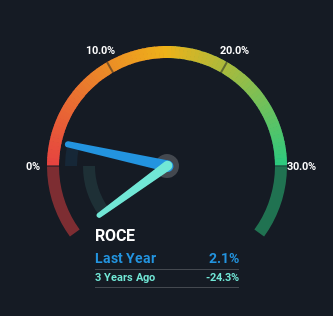
If you're looking for a multi-bagger, there's a few things to keep an eye out for. Amongst other things, we'll want to see two things; firstly, a growing return on capital employed (ROCE) and secondly, an expansion in the company's amount of capital employed. This shows us that it's a compounding machine, able to continually reinvest its earnings back into the business and generate higher returns. So when we looked at Buhler Industries (TSE:BUI) and its trend of ROCE, we really liked what we saw.
Return On Capital Employed (ROCE): What Is It?
If you haven't worked with ROCE before, it measures the 'return' (pre-tax profit) a company generates from capital employed in its business. Analysts use this formula to calculate it for Buhler Industries:
Return on Capital Employed = Earnings Before Interest and Tax (EBIT) ÷ (Total Assets - Current Liabilities)
0.021 = CA$2.8m ÷ (CA$233m - CA$97m) (Based on the trailing twelve months to June 2023).
So, Buhler Industries has an ROCE of 2.1%. In absolute terms, that's a low return and it also under-performs the Machinery industry average of 6.7%.
View our latest analysis for Buhler Industries

Historical performance is a great place to start when researching a stock so above you can see the gauge for Buhler Industries' ROCE against it's prior returns. If you'd like to look at how Buhler Industries has performed in the past in other metrics, you can view this free graph of past earnings, revenue and cash flow.
The Trend Of ROCE
Like most people, we're pleased that Buhler Industries is now generating some pretax earnings. Historically the company was generating losses but as we can see from the latest figures referenced above, they're now earning 2.1% on their capital employed. At first glance, it seems the business is getting more proficient at generating returns, because over the same period, the amount of capital employed has reduced by 21%. Buhler Industries could be selling under-performing assets since the ROCE is improving.
On a side note, Buhler Industries' current liabilities are still rather high at 42% of total assets. This effectively means that suppliers (or short-term creditors) are funding a large portion of the business, so just be aware that this can introduce some elements of risk. Ideally we'd like to see this reduce as that would mean fewer obligations bearing risks.
The Bottom Line
In summary, it's great to see that Buhler Industries has been able to turn things around and earn higher returns on lower amounts of capital. And since the stock has fallen 31% over the last five years, there might be an opportunity here. That being the case, research into the company's current valuation metrics and future prospects seems fitting.
If you'd like to know more about Buhler Industries, we've spotted 3 warning signs, and 2 of them are concerning.
If you want to search for solid companies with great earnings, check out this free list of companies with good balance sheets and impressive returns on equity.
Valuation is complex, but we're here to simplify it.
Discover if Buhler Industries might be undervalued or overvalued with our detailed analysis, featuring fair value estimates, potential risks, dividends, insider trades, and its financial condition.
Access Free AnalysisHave feedback on this article? Concerned about the content? Get in touch with us directly. Alternatively, email editorial-team (at) simplywallst.com.
This article by Simply Wall St is general in nature. We provide commentary based on historical data and analyst forecasts only using an unbiased methodology and our articles are not intended to be financial advice. It does not constitute a recommendation to buy or sell any stock, and does not take account of your objectives, or your financial situation. We aim to bring you long-term focused analysis driven by fundamental data. Note that our analysis may not factor in the latest price-sensitive company announcements or qualitative material. Simply Wall St has no position in any stocks mentioned.
About TSX:BUI
Buhler Industries
Through its subsidiaries, manufactures and sells agricultural equipment in North America.
Slight and fair value.
Market Insights
Community Narratives



